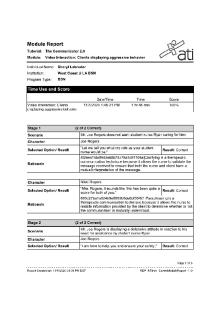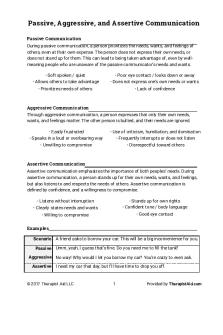Aggressive Working Policy PDF

| Title | Aggressive Working Policy |
|---|---|
| Author | Emer Liceralde |
| Course | Financial Management |
| Institution | University of Baguio |
| Pages | 2 |
| File Size | 55.4 KB |
| File Type | |
| Total Downloads | 14 |
| Total Views | 203 |
Summary
Working Capital Management...
Description
Advantages of Aggressive Strategy of Working Capital Financing The aggressive approach is a high risk strategy in Working Capital Management Policy. The advantage of this policy is that it increases profits by taking advantage of the interest rate since short term rates are usually lower than long-term rates. Aggressive working capital policy has a significant effect on firm value. An aggressive working capital policy is one in which you try to squeeze by with a minimal investment in current assets coupled with an extensive use of short-term credit. Your goal is to put as much money to work as possible to decrease the time needed to produce products, turn over inventory or deliver services. Speeding up your business cycle grows your sales and revenues. You keep little money on hand, cut slow-moving inventory and unnecessary supplies to the bone and stretch out your bill payments for as long as possible. The one payment you cannot delay is interest – your creditors can sue you, force you into bankruptcy and liquidate your assets. You would also want to avoid missing tax payments. The advantage of aggressive financial strategy is that it increases return on profitability by taking advantage of the cost differential between long-term and short-term debt. It is less expensive compared to conservative strategy and provides the company with greater profitability. An aggressive working capital policy increases profits by taking advantage of the interest rate differential that usually exists between long-term and short-term debt. Short-term rates are typically lower than long-term rates. In addition, short-term loans can be repaid when they are no longer needed, unlike long-term debt, which remains outstanding until maturity. This eliminates having unprofitable idle funds on hand. Lower Financing Cost, High Profitability In this strategy, the cost of interest is low because of the maximum usage of short term finances. There are two reasons of this. Firstly, the rate of interest is cheaper and secondly, in the off seasons, the loan can be repaid and hence, no idle funds. If the operating cycle is moving smoothly, it is called most effective working capital management. Lower Carrying and Handling Cost Lower level of inventory makes the carrying and holding cost also go down and that directly affect the profitability. Highly Efficient Working Capital Management The task of working capital manager is to smoothly run the operating cycle of the company with the lowest level of working capital. Precisely, that is what this strategy is all about. If the strategy is successful with no dissatisfied stakeholders, there is nothing better than this. An aggressive working capital policy increases profits by taking advantage of the interest rate differential that usually exists between long-term and short-term debt. Short-term rates are typically lower than long-term rates.
In addition, short-term loans can be repaid when they are no longer needed, unlike long-term debt, which remains outstanding until maturity. This eliminates having unprofitable idle funds on hand. Disadvantages of Conservative Strategy of Working Capital Financing Financing of temporary working capital with long-term funds results in increased interest costs when funds are idle. Firms incur interest expense when they have excess funds on hand and no need for additional temporary working capital. The lower risk of a conservative strategy also results in reduced profits because of the higher interest rate costs of long-term debt. Managers who are risk-takers are more comfortable with an aggressive financing strategy. It is the most profitable method of managing working capital, but it comes with the most risk. The conservative approach is less profitable but has the least risk....
Similar Free PDFs

Aggressive Working Policy
- 2 Pages

Working capital
- 48 Pages

Rajput policy
- 4 Pages

Policy Evaluation
- 4 Pages

Attendance Policy
- 2 Pages

Cybersecurity Policy
- 20 Pages

Working Capital Management Notes
- 17 Pages

Working Capital Management exam
- 15 Pages

WORKING CAPITAL MANAGEMENT
- 57 Pages

Audit Working Papers - Audit
- 6 Pages
Popular Institutions
- Tinajero National High School - Annex
- Politeknik Caltex Riau
- Yokohama City University
- SGT University
- University of Al-Qadisiyah
- Divine Word College of Vigan
- Techniek College Rotterdam
- Universidade de Santiago
- Universiti Teknologi MARA Cawangan Johor Kampus Pasir Gudang
- Poltekkes Kemenkes Yogyakarta
- Baguio City National High School
- Colegio san marcos
- preparatoria uno
- Centro de Bachillerato Tecnológico Industrial y de Servicios No. 107
- Dalian Maritime University
- Quang Trung Secondary School
- Colegio Tecnológico en Informática
- Corporación Regional de Educación Superior
- Grupo CEDVA
- Dar Al Uloom University
- Centro de Estudios Preuniversitarios de la Universidad Nacional de Ingeniería
- 上智大学
- Aakash International School, Nuna Majara
- San Felipe Neri Catholic School
- Kang Chiao International School - New Taipei City
- Misamis Occidental National High School
- Institución Educativa Escuela Normal Juan Ladrilleros
- Kolehiyo ng Pantukan
- Batanes State College
- Instituto Continental
- Sekolah Menengah Kejuruan Kesehatan Kaltara (Tarakan)
- Colegio de La Inmaculada Concepcion - Cebu





